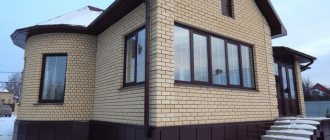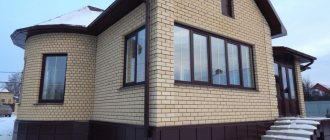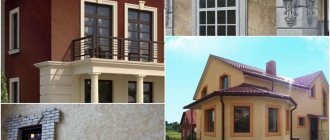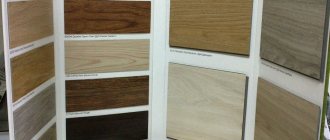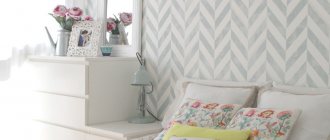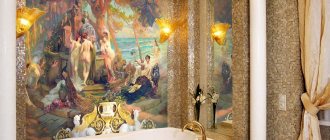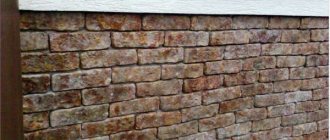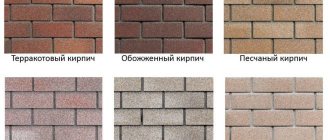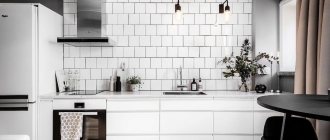Exterior decoration is no less important than interior decoration. The first impression is made by the appearance of the building. However, exterior finishing has a main feature: increased requirements for the materials used. They are constantly exposed to the negative influence of weather conditions and mechanical stress. Temperature changes, heavy rainfall, wind - these are just a few of them.
One of the materials for exterior finishing that meets all the requirements is facade tiles. It is not only reliable and durable, but also has a decent appearance. Since the range of products is varied, it is difficult to stop and choose a specific option. It is important to familiarize yourself with the types of products, learn all the advantages and disadvantages of the material for outdoor use and the technology for its installation.
Basic requirements for facade tiles
Buildings are exposed to many adverse effects from their facades - temperature changes, ultraviolet radiation, wind loads, high humidity, and mechanical damage. Therefore, all finishing materials have special requirements:
- mechanical strength;
- resistance to moisture;
- resistance to UV radiation;
- fire safety;
- resistance to chemical influences;
- frost resistance;
- durability;
- ease of care.
In addition, any facade facing tile must comply with environmental standards and also have a beautiful design. The cost of such products varies greatly - from budget to very expensive materials.
Specifications
Facade tiles are the best option for both private housing construction and office or commercial buildings. When choosing a material, it is necessary to take into account its technical characteristics. These indicators depend on the composition. In addition, there are a number of basic requirements that products must meet:
- durability;
- environmental friendliness;
- resistance to weather conditions, temperature changes and mechanical stress;
- fire safety;
- the ability to maintain an aesthetic appearance for a long time.
High quality products have all the specified characteristics. They may also have additional benefits. For example, a variety of sizes, shapes, etc.
Types of facade tiles
There are many options for tiles for finishing facades made from natural and artificial materials. The best tiles for the facade are selected based on color, texture, and properties.
You can combine 2 or several types of facing products, as well as combine them with other surfaces, for example, painted plaster.
Terracotta
Terracotta facing tiles for facades made of kaolin colored clay are included in a separate category of ceramics. The cladding usually has a non-standard format:
- tile length – up to 2 m;
- width – 1–8cm;
- thickness – 1–6 cm.
The uniqueness of terracotta lies in the fact that with high moisture absorption of 6–12% in winter, the tiles do not crack in the cold. Therefore, in the absence of vapor barrier films or membranes in the building envelope, terracotta tiles remain the best option for maintaining the vapor permeability of the walls of the cottage and ensuring natural regulation of the microclimate in the building. The cladding weighs less than concrete and clinker, is absolutely fireproof, does not emit harmful substances and does not fade from solar ultraviolet radiation.
Facade cladding with terracotta tiles
A natural stone
The most expensive and prestigious materials for facade finishing. They have high strength, durability, and other performance characteristics. Because they are so heavy, they require reinforced foundations, strong wall surfaces or strong frames for installation.
Natural stone facade tiles for the home are:
- Granite. Of all natural facing materials, it is particularly durable and weather-resistant. The surface can be matte or polished glossy. Installation requires good professional training.
- Marble. It is distinguished by a variety of colors and natural patterns. Gives the façade a rich, luxurious look. Compared to granite, it is less resistant to weathering because it absorbs moisture due to its porous structure. Therefore, marble surfaces are treated with special protective compounds containing wax. Installation must be carried out by specialists.
- From shell rock. This is a special type of limestone with a porous structure. Shell rock is much cheaper than marble and granite and is widely used for finishing facades and interiors. The unusual texture of such tiles gives the walls freshness and originality. Due to its porosity, the material adheres well to the wall surface. For exterior finishing, you need to choose the densest type of shell rock - grade M35. It is better to carry out installation in warm, clear weather, but not in frost, rain, or heat. To reduce moisture absorption, the tiles are treated with special compounds.
- Made of sandstone. Inexpensive, environmentally friendly material of natural origin. It can be porous or denser. To decorate a house with sandstone facade tiles, you should choose only dense varieties - porous ones will deteriorate over time due to exposure to moisture and temperature changes.
Advantages of the material
External facing tiles are gaining more and more popularity. Previously, it was hard to imagine that it would become widespread for cladding facades. But now you can see her more and more often. Although the material has some disadvantages and is inferior in certain characteristics to its analogues, it also has its own characteristics. They make some of the best products when it comes to exterior facade decoration.
Advantages:
- Strength. Plinth tiles can withstand high mechanical loads. Depending on the type, it resists acupressure. Before purchasing, you should choose the best option for your needs.
- Vapor permeability. A parameter that must be taken into account when finishing a building.
- Moisture-proof. Moisture causes irreparable damage to the base and the structure as a whole. Basement tiles withstand constant exposure to moisture. Dampness will not penetrate under it, deformation, the formation of fungus and mold are excluded.
- Easy to install. The work cannot be called easy, but there is nothing complicated about it either. Everything is done with your own hands. All you need is detailed instructions and the desire to work. In addition, the installation methods are different, you can choose the optimal one.
- Huge assortment. There are dozens of varieties of outdoor tiles available. They have their own characteristics, positive and negative sides. And thanks to the variety of colors and textures, you can make a building in a certain style.
- Ability to hide surface imperfections. One of the installation methods is dry, by fixing it to a frame. Thanks to this, there is no need to level the surface to perfection, wasting time, money and effort on this.
- Ecological cleanliness. External plinth tiles of any kind are made from natural and environmentally friendly materials. It will not affect the health of the family or the environment in any way.
- Long service life. If you follow the installation technology and buy high-quality external material, it will last more than 30–40 years.
According to experts, external facing tiles can be combined with each other. For example, to save money, it is enough to buy two types of outdoor tiles: expensive/high-quality and medium-cost material. By combining them with each other you can get reliable coverage at a lower price.
Agglomerate tiles
It is an artificial stone material obtained from crumbs of spar, granite, quartz, expanded clay with the addition of binders. The mixture is pressed under high temperatures.
In some performance characteristics it surpasses even natural stone. And the cost is much cheaper. Therefore, it is very popular for finishing facades.
A wide variety of design options are available for finishing a house with agglomerate facade tiles. Surfaces come with imitation of various materials, a wide choice of colors. Most often, agglomerate tiles are used to create suspended, ventilated facades.
Note!
Epoxy grout for tiles: pros and cons, scope, varieties, how to work with it (instructions + photos)
Do-it-yourself tile shower tray step by step: instructions, dimensions, design, installation of communications, types of structures, photos
White tiles in the bathroom: 170 photos of the best ideas and new tile designs. Layout schemes and beautiful combinations
Porcelain tiles
Porcelain tiles appeared relatively recently, but have already gained unprecedented popularity. For the production of products, granite chips, expanded clay and a number of additives are used.
It is believed that this type of finish is the most convenient in terms of installation. Every novice craftsman knows how to attach facade tiles. Moreover, this particular material for wall decoration perfectly withstands low temperatures. You can safely decorate any external surfaces with porcelain stoneware.
Another important advantage is its pronounced aesthetic value. Often, porcelain stoneware imitates natural textures so skillfully that it can replace any artificial stone.
The disadvantages include the fact that a mosaic of such elements most likely will not work. The cladding made from such tiles ends up being quite heavy in weight, so it’s still not worth using the material to decorate lightweight structures.
Ceramic tile
This type of tile is not much different from the usual one used for interior decoration. But the main thing is that ceramic tiles for external walls must be frost-resistant, otherwise they will quickly crack in the first winter season.
Unlike interior varieties, ceramic facade tiles do not have such a variety of decor. These are mostly plain, dim products, imitating brick or stone.
Where to buy facing tiles for facades?
Buy in Moscow:
- st. Admirala Makarova, 15. tel.: +7 (495) 22-33-22-7.
- Varshavskoe sh., 46, BC "Southern Cross". tel.:+7.
- st. 2ya Karpatskaya 4, office 301. tel.: +7 (495) 649-45-12.
Buy in St. Petersburg:
- Sales office TOP HOUSE st. Kuznetsovskaya, 10, tel.: +7 (812) 244-95-25.
- TOP HOUSE sales office Leninsky pr., 104, tel.: +7 (812) 244-95-30.
- TOP HOUSE sales office Oktyabrskaya embankment, 44, tel.: +7.
Porcelain tiles
It is similar to ceramic, only it has higher strength, wear resistance and other performance characteristics. The appearance resembles natural stone.
The composition includes white clay with an admixture of kaolin, quartz, spar, and various additives. Obtained by pressing under high pressure and temperature. Facade tiles are made to look like brick or other materials.
How to make your home “dressy”?
The visual perception of a façade is influenced by many factors. The right color is important. Dark chocolate tones and natural “stone” textures add solidity and high value; multi-color mosaics make the exterior colorful and unusual.
Beige cladding will look elegant even on the darkened side of the house. Facade tiles “torn stone” with multi-colored inclusions will make a simple facade devoid of additional decorative elements, more complex in architecture and stylistic composition.
The texture can also give a certain respectability to the building, rid the façade of monotony and dullness. The simplest façade tiles with a pleasant glossy shine will instantly transform the “face of the house.” Decorating walls with natural stone or using porcelain stoneware parts will give a special festive look to the facade.
Clinker tiles
Clinker façade tiles are made like ceramic tiles from clay, only they contain the slate variety with various additives.
Note!
Italian tiles for floors and walls: photos of beautiful tile designs in the bathroom and kitchen. Choosing tile color, style and size
Marble tiles for the bathroom: TOP-200 photos of original design, ideas for mixing and matching
Do-it-yourself tile shower step by step: instructions, algorithm of actions, dimensions, layout diagrams, photo of a shower with and without a tray
Formed under high pressure from a clay mass, the tiles are fired at high temperatures. The result is a beautiful finishing material that has high resistance to cracking, moisture resistance, and frost resistance.
Main manufacturers
The building materials market is filled with a wide selection of products manufactured using modern technology and standards.
There are several companies whose products have proven themselves well. Firms from Germany, Poland, and the Czech Republic use high-tech production methods. This makes their products in demand in many countries. Such manufacturers include the following brands: ArGeTon, Feldhaus, Cerrad, Lasselsberger Rako, Roben, etc. In the post-Soviet space, InterKam, Romantile, and Canyon are engaged in the production of high-quality finishing products.
The facade tiles of these companies can fully replace both natural stone and brick. In this case, the outer surface will perfectly imitate any of their appearance.
Concrete tiles
It is obtained by pouring concrete into molds. Cheap available material, large selection of textures and colors. It is quite massive, so you need a solid foundation and strong wall surfaces.
To reduce weight, porous fillers are often added to mixtures. The technology for producing tiles is simple, accessible for self-production.
But it is not recommended to make homemade tiles for wall decoration - factory-made products are of higher quality. Installation is simple, accessible even to beginners. Performance characteristics are average.
What to look for when choosing
When choosing products for exterior cladding of a house, you should consider some recommendations. This:
- Texture of the material. The textured surface looks three-dimensional, interesting, easy to install, and has good adhesion to the wall surface. But dust accumulates on relief models, which is difficult to get rid of. Glazed, smooth tiles create a monolithic surface, do not require special care, but are difficult to install.
- Color solution. When choosing, you should start from the purpose of the building. For commercial purposes, monochromatic products are more suitable. Natural, light shades are better suited for cladding a residential building. Dark colors can be purchased for finishing the base.
- Product integrity. There should be no delamination, swelling, or cracks on the surface of the products.
You need to find out the composition of the product from the seller, and read all the markings on the packaging: weight, tensile strength, frost resistance, water absorption level.
Polymer sand tiles
They are made from sand, polymers, dyes, and various additives. The mixture is poured into molds and under the influence of high pressure and temperature it becomes very strong. light weight tiles.
It is resistant to moisture, acidic environments, frost-resistant, and is easy to clean from dirt. Refers to the cheapest types of tiles.
Note!
Mosaic from broken tiles: step-by-step instructions on how to lay it out with your own hands (140 photo ideas)
Mosaic for the bathroom: TOP-150 photos of new designs, as well as modern ideas for combining mosaic tiles
Do-it-yourself water heated floor under tiles step by step: installation instructions with photos and descriptions, installation and connection
Ceramics
Regular tiles are not suitable for outdoor use. It will quickly crack from frost. But some manufacturers produce special facade ceramics.
Ceramic tiles Benadresa Nuey (Spain).
Facade ceramic tiles Creaton (Germany).
Terracotta tiles
Made from fired kaolin clay without applying glaze. Completely natural material without chemical additives or dyes. Different shades are obtained by mixing different types of clay. The range of colors ranges from light beige to dark brown.
Terracotta tiles are resistant to low and high temperatures, durable, and easy to install. This cheap material is not inferior in attractiveness to more expensive products.
Important points to consider when tiling the facade yourself
Quite a bit of practical knowledge and skills are required to cladding a house yourself. Some recommendations should be highlighted that will help carry out this process more efficiently:
- It is better to carry out styling in the summer when it is warm. The optimal temperature is 5-25 degrees. If the weather is hotter outside, then experts recommend slightly moistening the back surface of the tile;
- Before laying, it is necessary to level the walls by plastering. And then the use of reinforcing mesh is encouraged.
So, we see that the variety of finishing tiles for the facade is amazing in variety. The cost per square meter depends on the type of tile. Installation work for this type of finishing is not cheap, so you should think about installing it yourself. It is enough to consult a little with knowledgeable people and read the recommendations of specialists.
Flexible bitumen tiles
It belongs to economy class materials, but has a very attractive appearance and good performance characteristics.
The composition of such flexible facade tiles is identical to bituminous shingles. Its base consists of fiberglass and improved bitumen, and a decorative and protective layer of basalt granulate is applied on top.
Advantages:
- a light weight;
- ease of installation using glue and nails, the surface of the walls must be perfectly flat;
- soft facade tiles are quickly installed in entire sections;
- excellent tightness;
- resistance to UV rays, temperature changes, moisture;
- beautiful view;
- affordable price.
OSB boards
Working with this material has some peculiarities. Structurally, it consists of layers of wood chips directed in different directions, due to which the strength of the products is achieved. Contains wax, which imparts water-repellent properties and prevents the formation of mold and mildew.
Despite all the advantages, the material is most often used not for cladding, but for leveling walls. However, such finishing will require additional priming, plaster or siding panels, clinker tile cladding.
Recommendations for choosing tiles
When purchasing exterior façade tiles, the following important factors must be taken into account:
- financial opportunities;
- compatibility of the material with the design style of the building, color scheme;
- climatic features - how resistant the products will be to local weather conditions;
- type of foundation - some types of tiles can make the structure too heavy and require a reinforced base;
- compatibility of cladding and wall materials;
- what type of installation will be required - consider additional costs in advance;
- manufacturer - it is better to choose well-known brands, including TechnoNIKOL facade tiles;
- too low or high price for this type of tile should alert you;
- it is necessary to obtain information from the seller about the composition of the product;
- pay attention to all important markings - choose frost resistance above 50 cycles, water absorption no more than 5%, bending strength not less than 180 MPa, etc.;
- check the integrity and condition of the packaging - if it is damaged, swollen or streaked with moisture, most likely the conditions for transporting and storing the goods were not met.
How to sew seams - step by step instructions
They are filled with a solution to bind all the elements into a single whole. This also promotes enhanced sealing of seams. After this procedure, the facade looks noble, and the finishing is less exposed to the aggressive influence of the external environment. Grouting is performed in several stages. Each of them has its own characteristics.
Step 1. Moisturize the seams. Before starting work, you need to wait until the solution dries completely - from 10 to 15 days . If you start unstitching the seams ahead of schedule, this will negatively affect the strength of the finish.
Attention! The water that is part of the adhesive mixture will not find a way out and will destroy the facade from the inside. This is especially dangerous for regions with extremely low air temperatures in winter.
Working with seams begins with moistening them. A sprayer is used for this. Wetting with water improves adhesion between surfaces. It is necessary to moisten the seams in all directions - both horizontally and vertically.
Moisturizing with a brush
Step 2. Mixing the solution. A mixture based on lime and cement has good plasticity. It is easy to level and distribute over the work surface. Cement in its pure form is not suitable for this. It can only be used with the addition of plasticizers to ensure normal hardening of the mixture.
Mixture manufacturing process
Construction mixer price
Construction mixer
To prepare the solution you will need the following components:
- cement - 1 bucket;
- slaked lime - 1 bucket;
- sand - 5 buckets.
Instead of lime, you can use a liquid plasticizer. The solution is mixed in a certain order:
- Add water in small portions. Regular tap water will do.
- Stir the mixture continuously until it becomes homogeneous and has a consistency similar to wet sand, which sticks together well if crushed.
- The finished mixture is used for 2 hours . Then the solution hardens and becomes unsuitable for work. Even if you dilute it with water, it will not help improve adhesion between surfaces.
If you don’t want to prepare the mixture yourself, you can buy a ready-made one. Then it is used in accordance with the instructions that come with it.
Ready mixture for joints
Note! The strength of the solution depends not only on compliance with the technology of mixing it. This is also affected by the base on which the mixture is applied. It should be clean and smooth.
Step 3. Filling the seams. The moistened surface is filled with the prepared solution. This is done as follows:
- The composition is drawn onto a spatula.
- Using a trowel, the mixture is pushed into the open seam.
- Compact the seam. To do this, iron it with a trowel with slight pressure.
The consumption of the composition for tiles with a thickness of 8 to 12 mm will be in the range of 4-5 kg per 1 sq.m. During operation, part of the grout mixture crumbles. To save money, it is better to lay clean plastic film on the floor. The crumbled solution can be carefully collected and used for its intended purpose.
Filling seams with a gun
Prices for a sealant gun
Caulking gun
Step 4. Clean and moisten the seams. After compacting, you need to remove any remaining mortar from the tiles. To do this, carefully sweep the finish with a soft bristle brush or soft brush.
Advice! Movements are performed diagonally. Then you can easily remove the excess mixture without damaging the seams.
After this, the seams are sprayed with water from a spray bottle. This helps prevent the mortar from drying out prematurely and cracking.
Finished seams on the facade of a building
Video - How to grout seams on hand-molded clinker tiles
Facade tile cladding technology
There are 2 main methods of finishing facade tiles - they are performed using wet and dry technology. The choice depends on the type of walls and the characteristics of finishing materials. Before each method, preliminary preparation of the base is required.
Wet lining
Installation is carried out using special glue. Surfaces must be perfectly flat. Therefore, they are first cleaned, leveled, plastered, and primed. Only moisture-resistant glue is suitable and is selected individually for each type of material. In this way, only light-weight tile materials can be installed.
For better adhesion, apply the adhesive to the wall with a spatula in one direction, and to the tiles in the opposite direction. Each product is pressed tightly against the wall, and excess glue protruding along the edges is immediately cleaned off. After drying, the seams are treated with moisture-resistant grout.
For your information: HAUBERK bitumen facade tiles, produced by TechnoNIKOL, are an innovative finishing material that has no analogues. For cladding vertical surfaces, two collections with imitation brick and stone have been created.
Dry lining
This installation method is carried out using frame technology. A metal or wooden sheathing is pre-installed, onto which the tiles are then mounted using clamps.
This technology is more complex and requires additional time and money to prepare the frame. Clamps are attached to the sheathing, into the grooves of which the tiles are then inserted.
Such facades are called ventilated, because there is free space between the tiles and the wall. It is often filled with insulation to create external thermal insulation. Use mineral wool or polystyrene foam, which are attached to the wall with plastic nails with wide heads.
Interesting combination
It is worth mentioning the interesting combination of clinker facade tiles and thermal panels. This combination of materials allows not only to aesthetically enrich the facade of any house, but also to significantly insulate the building.
The effect of significant insulation is achieved due to the special composition of thermal panels. To make them you will need polyurethane, marble chips and sand. Upon completion of the installation of the soft insulating base, clinker facade tiles are installed on the walls, the characteristics of which are pleasing in all respects.
